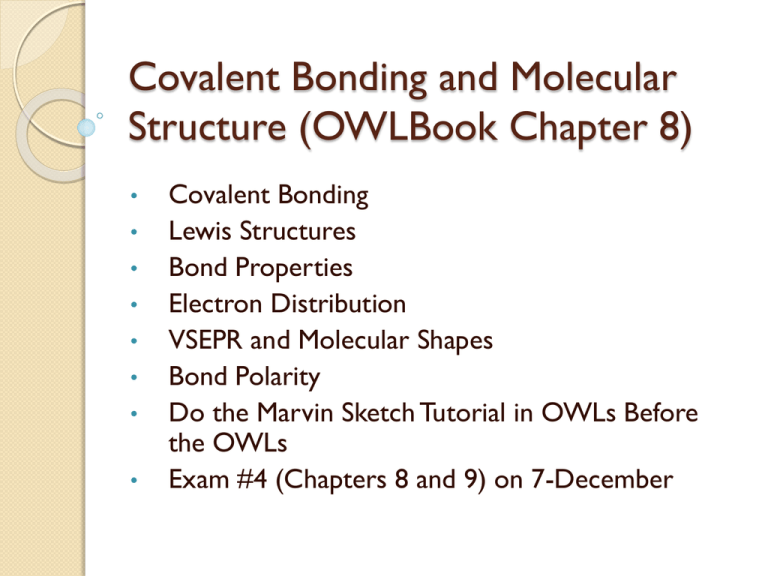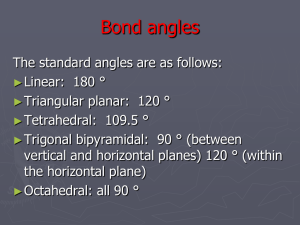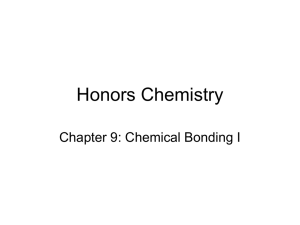
Covalent Bonding and Molecular
Structure (OWLBook Chapter 8)
•
•
•
•
•
•
•
•
Covalent Bonding
Lewis Structures
Bond Properties
Electron Distribution
VSEPR and Molecular Shapes
Bond Polarity
Do the Marvin Sketch Tutorial in OWLs Before
the OWLs
Exam #4 (Chapters 8 and 9) on 7-December
Covalent Bonding
Coulombs Law (Ionic Bonds)
◦ Describes the forces most involved in ionic
bonds
Bonds based almost solely on electrostatic forces
In contrast, this is an Ionic Bond.
Evaluating Covalent Bonding
Lewis Structures
◦ Used to examine the number of valence
electrons and how they may bond
◦ Generally, atoms prefer to have eight valence
electrons around them when bonded
When atoms are not bonded (by themselves)
Group number for the “A” or main group group elements
More complicated for transition elements
◦ Elements preferring other than 8?
H (2), B (6), S, P, Br
Drawing Lewis Structures
For atoms and ions
◦ Determine the number of valence electrons
Usually the group number
Can be evaluated from the electron configuration
also
◦ Write the atomic symbol
◦ Arrange electrons about the symbol
◦ Add or subtract electrons for ions
Enclose in brackets and add charge
Chlorine and chloride ?
Zinc and zinc ion ?
Lewis Structures and Molecules
Lewis structures help describe modes of
bonding AND shapes
Try to follow the octet (8) rule when it is
appropriate
◦ Evaluate the total number of electrons
◦ Determine which is the central atom (usually the
single one)
Furthest from fluorine (lowest e- affinity)
◦ Add one pair (bond between atoms)
◦ Distribute electrons
Evaluate compliance with the octet rule
Examples….
Remember that a line ( - ) is the same as a
pair of electrons (:)
◦ Hydrochloric acid
◦ Ammonia
◦ Boron trifluoride
◦ Ammonium ion
◦ Sulfate ion
Why are Lewis Structures
Important?
Methane (CH4)
Carbon Dioxide ?
Carbon Monoxide
Resonance Structures
Different (visually) but
ordinarily equivalent Lewis
Structures
Help distribute electrons (and
thus charge) throughout an
ion or molecule
◦ Stabilizes the ion or molecule
Help satisfy the Octet Rule
Very important in Organic
Chemistry
CH3COOValence electrons: 2(4) + 3(1) + 2(6) + 1 = 24
C is the central atom.
A double bond is needed between C—O.
There are two equivalent places for it, so two
resonance structures are required.
H
H
-
-
O
H
C
C
O
H
C
O
H
C
O
H
Carbonate Ion ?
Bond Properties
Bond length (or bond distance) is the
distance between nuclei in a bond.
Bond order is, defined in terms of the Lewis
formula, the number of pairs of electrons in a
bond.
Bond energy is, defined in terms of
thermodynamics, the energy required to break
a bond (separate the nuclei so they no longer
can “detect” each others presence) in a gasphase molecule.
Consider the propylene molecule:
H
H
C
134 pm
H
C
H
C
H
H
150 pm
One of the carbon–carbon bonds has a length of 150
pm; the other 134 pm. Identify each bond with a bond
length.
The shorter bond is the double bond;
the longer bond is the single bond.
Copyright © Cengage Learning. All rights reserved.
9 | 19
Electron Distribution
Formal Charge
Electronegativity
Polarity
Resonance
Formal Charge
Represents the distribution
of charge in a bond
◦ Relative to the # of valence
electrons each atom had originally
◦ A value assuming all electrons in a
bond are equally shared
Usefully in determining where electrons
might be in a Lewis Dot Structure for a
molecule
Total of Formal Charges = Overall Charge
on Molecule (0) or Ion (+ or -)
Electronegativity
The
tendency of an atom to draw
electrons in a bond towards it
◦ Electrons are not normally shared equally
The difference in electronegativity between the two
atoms in a bond is a rough measure of bond polarity.
Using electronegativities, arrange the
following bonds in order by increasing
polarity: C—N, Na—F, O—H.
For C—N, the difference is
3.0 (N) – 2.5 (C) = 0.5.
For Na—F, the difference is
4.0 (F) – 0.9 (Na) = 3.1.
For O—H, the difference is 3.5
(O) – 2.1 (H) = 1.4.
Bond polarities:
C—N < O—H < Na—F
Resonance, Formal Charge and
Electronegativity
All of these factor into the distribution of electrons in
a molecule or ion.
◦ Formal charge shows the best distribution of electronsmore towards more electronegative atoms
◦ Electronegativity describes bond polarity
◦ Resonance helps stabilize molecules and ions
Which is more likely?
In general……
Lowest value of formal charges
◦ 1,0,-1 is preferred over 3, 0, -3
Charge distributed somewhat throughout
the molecule
Negative formal charges on more
electronegative elements
VSEPR (Valence Shell Electron Pair Repulsion) Theory
Allows us to predict the shapes of
non-metal containing ions and
molecules
Central atom is surrounded by
structural electron pairs
Structural e- pairs can be
◦ Non-bonding (lone pairs)
◦ Bonding (between atoms)
Electron pair geometry is the
arrangement of structural e- pairs
around the central atom(s)
Molecular geometry is the
arrangement of atoms around the
central atom(s)
Electron Pair Geometry
(if all electrons are structural it is the same as molecular geometry)
Molecular Geometry
The same as electron
pair geometry when
there are no lone
pairs.
Different than electron
pair geometry when
there are lone pairs
Lone pairs want to be
physically as far apart
as possible in 3dimensional space
Molecular Polarity
For a molecule to be
polar, it must contain
polar bonds, and they
must be distributed
asymmetrically
Polarity impacts
◦
◦
◦
◦
Reactivity
Crystal structure
Solubility
Properties
BP, MP, etc.
Molecular Polarity
Determining
Polarity
◦ Draw Lewis
Structure
◦ Determine Molecular
Shape
◦ Assign polarity to
bonds
◦ Determine if there is
an uneven
distribution of charge
The dipole moment
is measure of
polarity.
Let’s draw these
molecules.







